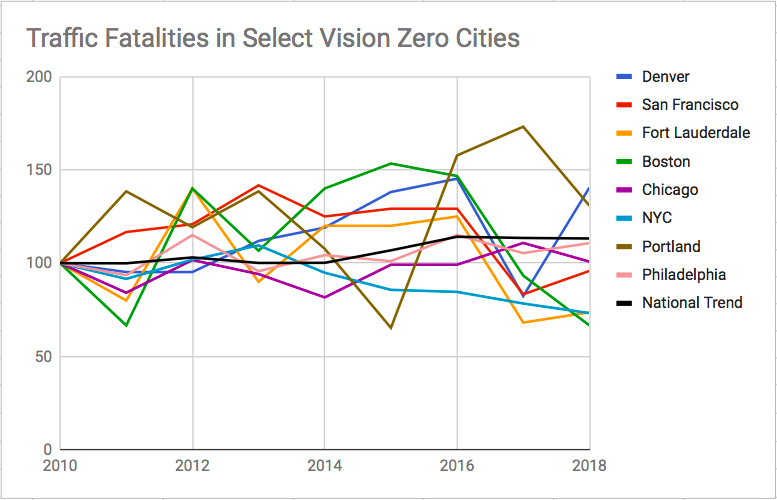Cities are struggling to make good on their Vision Zero promises and, just maybe, starting to make progress toward the goal of zero deaths.
It's too soon to say definitively for sure. But there are some encouraging signs in the fatality data from a handful of Vision Zero cities since 2010.
The above graph, compiled by Streetsblog, shows the rate of change in traffic fatalities using 2010 as a baseline. The national fatality trend is shown in black for reference. As you can see, there appears to be some progress happening since 2016 in at least a handful of cities. (Note: Each city started Vision Zero at different dates and the selection of 2010 as the baseline is arbitrary.)
Seattle, Boston, Portland, New York have seen fairly steady declines over the last few years — a good sign that their programs are starting to have an impact. But the trend is so recent that a single bad year could wipe out any sign of progress.
In at least two cities — New York and San Francisco — a pattern toward lower deaths seemed to be emerging when we checked in last year. The picture, however, looked a lot more mixed overall then.
New York's progress is especially illuminating because, being such a large city, it mutes some of the noise that one or two random deaths could add to the overall trend. There is a lot more noise — variation year to year — in smaller cities like Portland and Denver (in brown and dark blue, respectively, on the graph).
Advocates in a variety of cities say they see progress, but are also quick to point out that not enough is being done to reduce traffic deaths to zero or to dramatically lower serious injuries.
Jonathan Maus, publisher of the advocacy news site Bike Portland, said the Rose City has made some admirable strides, including lowering the default speed limit to 20 miles per hour citywide, for example.
"But not nearly fast enough," Maus told Streetsblog. "The only way we achieve Vision Zero is with a radical change to how we regulate, design for, and talk about cars and driving. I think the City of Portland understands this; but I don't think they are strong enough politically speaking to make it happen yet."
Randy LoBasso at the Bicycle Coalition of Greater Philadelphia said so far that city's effort has been underwhelming.
"Philadelphia’s current mayor came into office with a strong mandate for big transportation changes, but, at least in the short-term, has so far fallen short," he said.
Mayor Jim Kenney promised 30 miles of protected bike lanes when he took office in 2016.
"We’ve got about 2.5 miles, so far. That’s not good," said LoBasso. "But there are, by our count, at least 14 protected bike lane projects in the pipeline that’ve been approved to be installed on streets that are up for repaving in 2019 and 2020."
Advocates in Washington, D.C., and New York also said their mayors are not doing enough. So far in 2019, traffic deaths in New York are up 20 percent over the same period last year. If fatalities continue at their current pace, the city will have 280 fatalities next year, StreetsblogNYC reports.
In D.C., where advocates complained Vision Zero was little more than a marketing slogan, a truly bold approach was recently put forth that would not only mandate the installation of protected bike lanes wherever the city's master plan calls for it, but it would also ban the right-on-red, lower speed limits and even ramp up enforcement on bike lane parkers.
Leah Shahum, director of the Vision Zero Network, a nonprofit that helps promote cities traffic safety efforts, says it's always difficult to see the success of Vision Zero in snapshots like the one at the top of this story.
"Progress toward Vision Zero is not likely to be linear," she said in a statement. "It will take transformative change — which is not quick or easy — to shift from the traditional, reactive approach focused on influencing individual behavior toward a new systems-based approach that gives the policymakers and system designers the mandate and responsibility to prioritize safety in all their decision making."
But there is one thing that always matters, Shahum added.
"This will take time and leadership and the political courage to do what works," she said.





